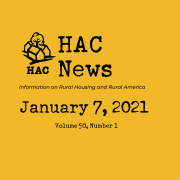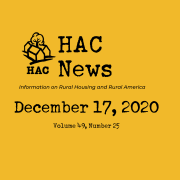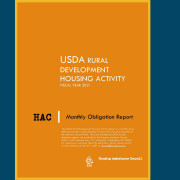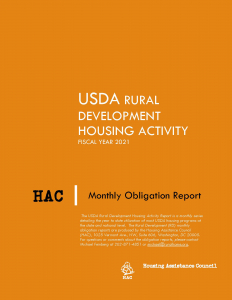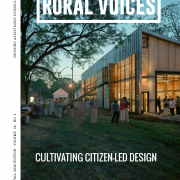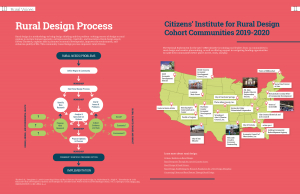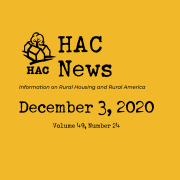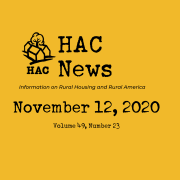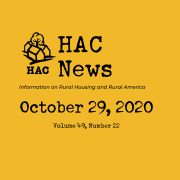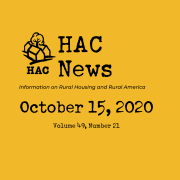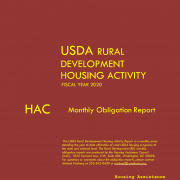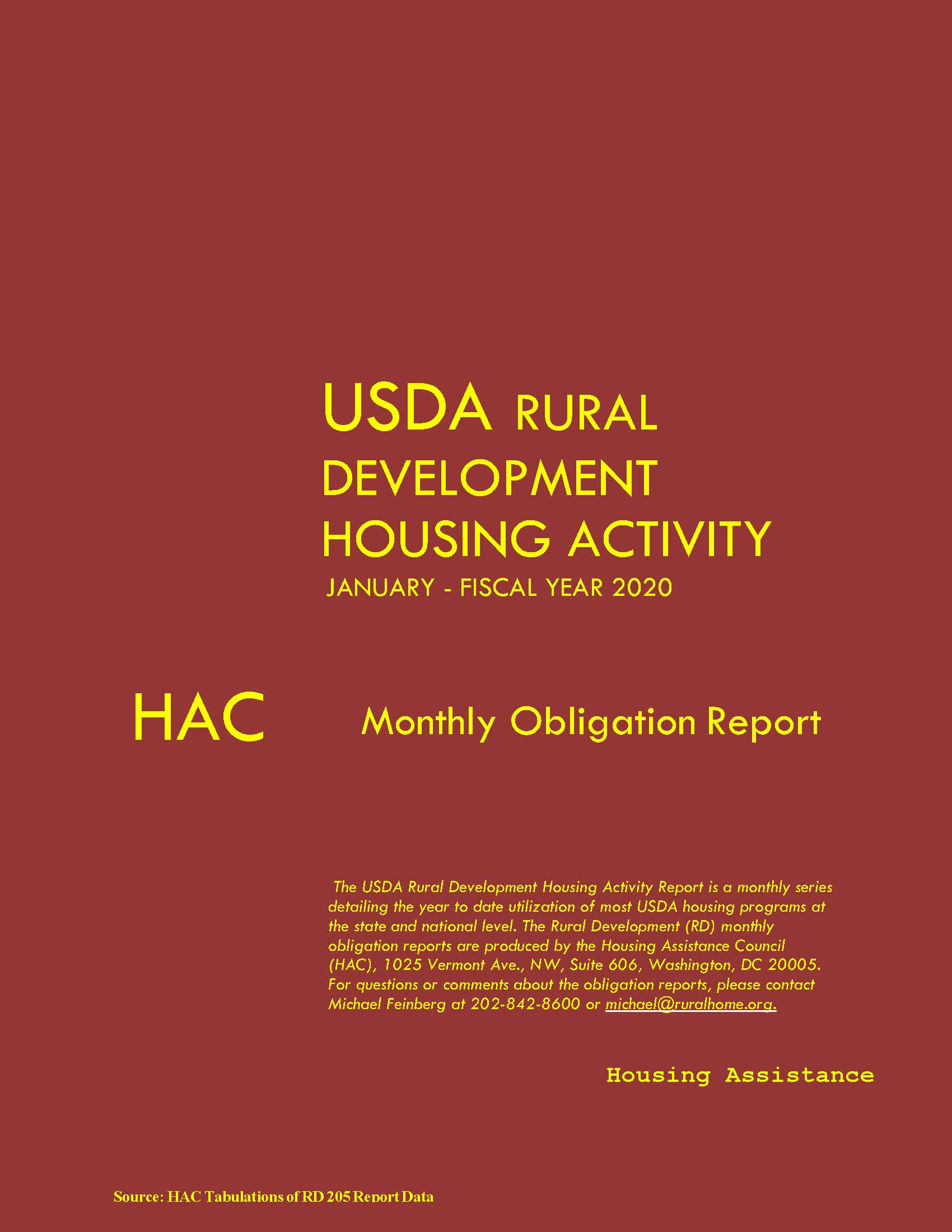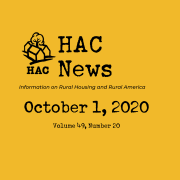HAC News: January 7, 2021
HAC News Formats. pdf
January 7, 2021
Vol. 50, No. 1
TOP STORIES
Eviction moratorium and rent aid included in final coronavirus relief package.
- The coronavirus relief legislation enacted in late December extends through January 31 the Centers for Disease Control’s nationwide moratorium on evictions of tenants for non-payment of rent. CDC has updated its declaration for tenants and its Frequently Asked Questions document to reflect the new expiration date. The revised FAQ also now points out that state or local law may allow a landlord to challenge the truthfulness of a tenant’s declaration. USDA issued a reminder about the moratorium’s applicability to USDA-financed rentals.
- The law also provides $25 billion for a new Emergency Rental Assistance program. The Treasury Department will distribute ERA funds to states, local governments with populations of at least 200,000 and tribes. Eligible government entities must submit information to Treasury by January 12 in order to receive funds.
- Among its other provisions, the law extends the deadline for states, localities and tribes to use CARES Act Coronavirus Relief Funds to December 31, 2021; revives the Paycheck Protection Program and other aid for small businesses (more information under Opportunities below); and provides funding for broadband and for CDFIs.
Agencies extend housing relief into 2021.
Federal housing agencies are again extending special provisions that were put into effect early in 2020 to help people deal with the impacts of the coronavirus pandemic, including moratoriums on foreclosures and evictions, forbearance for owners of single-family or multifamily properties, and waivers of some requirements. HAC has posted a table showing the status of these extensions, and will update it as more are announced.
Most rural housing programs have level funding for FY21.
The final omnibus appropriations measure for fiscal year 2021, signed into law on December 27 as part of the package that also included coronavirus relief, holds most USDA rural housing programs at FY20 levels. It provides increases for Section 521 Rental Assistance and Section 542 vouchers. HUD’s HOME, CDBG, SHOP and Native American housing programs also receive the same funding as last year or small increases. Dollar levels for homeless assistance, HUD vouchers, Section 202, Section 811 and fair housing are increased.
Permanent floor set for 4% Low-Income Housing Tax Credit.
The legislative package that includes the coronavirus relief bill and omnibus appropriations also establishes 4% as the minimum rate for the 4% Low-Income Housing Tax Credit, effective immediately. LIHTC experts at Novogradac estimate this change could finance an additional 130,000 rental units in the next ten years.
RuralSTAT
In 2020, from February 20 – the first reported case of COVID-19 outside a metropolitan area – to December 31, there were 3 million reported cases and over 52,000 reported deaths from the coronavirus in rural America. Source: Housing Assistance Council tabulations of New York Times COVID-19 data.
OPPORTUNITIES
HAC seeks proposals for Affordable Housing for Rural Veterans Initiative.
HAC’s Affordable Housing for Rural Veterans initiative supports local nonprofit housing development organizations that meet or help meet the affordable housing needs of veterans in rural places. Grants typically range up to $30,000 per organization and must support bricks-and-mortar projects that assist low-income, elderly and/or disabled veterans with home repair and rehab needs, support homeless veterans, help veterans become homeowners and/or secure affordable rental housing. AHRV is funded through the generous support of the Home Depot Foundation. Applications are due by February 1. For more information, contact HAC staff, ahrv@ruralhome.org. No phone calls please.
Rural microenterprise loans offered by USDA.
USDA is seeking nonprofit entities, institutions of higher education and tribes to serve as partners for its Rural Microentrepreneur Assistance Program (RMAP). It will provide loans and technical assistance grants for applicants to support rural microenterprises. Deadlines are March 31 and June 30. For additional information, contact a USDA RD state office.
HAC job openings: Community Facilities Housing Specialist, Loan Officer, Senior Portfolio Manager.
For details, visit HAC’s website.
- The Community Facilities Housing Specialist identifies and engages community stakeholders and provides direct technical assistance to rural organizations that are developing facilities such as parks, community centers, public libraries and childcare centers. This includes helping them identify, utilize and apply for financial resources such as USDA Community Facilities grants and loans. This a two-year position and is eligible for telecommuting.
- The Loan Officer represents HAC in its lending activities – to include loan underwriting, marketing, and research and product development – and originates new loan transactions. This position is based in HAC’s Washington, DC headquarters and is eligible for telecommuting.
- The Senior Portfolio Manager provides leadership and oversight to a team that performs a range of lending activities – closing, disbursement, monitoring, servicing and asset management of single-family and multifamily housing development loans. This position is based in HAC’s Washington, DC headquarters and is eligible for telecommuting.
Paycheck Protection Program to restart.
A summary of the new coronavirus relief bill’s Paycheck Protection Program provisions is available on HAC’s site. The maximum loan amount will be $2 million, down from $10 million for the first PPP. Loans will be available for businesses that qualified under the CARES Act but did not receive a PPP loan, those that did receive one but need additional funding, and those that returned all or part of one. The Treasury Department and Small Business Administration have developed two interim regulations (here and here) to govern the second PPP round. Comments will be due 30 days after the rules are published in the Federal Register. The two agencies also have a new PPP document titled “Guidance on Accessing Capital for Minority, Underserved, Veteran and Women-Owned Business Concerns.”
CORONAVIRUS
Delivering vaccinations through pharmacies disadvantages some rural places.
The U.S. Department of Health and Human Services plans to increase access to COVID-19 vaccinations through partnerships with large chain pharmacies and networks that represent independent pharmacies and regional chains. A recent Rural Policy Research Institute study found, however, that in 750 (out of a total of 1,962) counties outside metropolitan areas there are no pharmacies affiliated with one of HHS’s partnerships. In 110 counties there are no eligible pharmacies at all.
“Rural Downtowns Were on the Mend. Then Came Covid.”
This Bloomberg opinion piece explains that certain rural areas, particularly those involved in tourism, experienced considerable economic growth by investing in their downtown areas, but the coronavirus pandemic set them back. The author suggests that attracting people relocating from urban areas, along with well planned and targeted investment, can help them recover.
REGULATIONS AND FEDERAL AGENCIES
USDA releases annual tenant data.
Characteristics of tenants in USDA’s Section 515 rental and Section 514/516 farmworker housing properties changed very little from September 2019 to September 2020, according to USDA’s annual summary of tenant data. Average annual income of Section 515 tenants rose from $13,551 in September 2019 to $13,640 in September 2020, while the average income for Section 515 tenants receiving Section 521 Rental Assistance was $11,380 in 2020. About 10.6% of all tenants in USDA’s portfolio remain rent burdened and almost 70% of tenants continue to receive rental assistance of some sort. Elders and people with disabilities comprise 65.3% of Section 515 households.
Fannie Mae and Freddie Mac affordable housing goals and Duty to Serve plans set for 2021.
The Federal Housing Finance Agency has announced Fannie Mae’s and Freddie Mac’s 2021 goals for purchases of affordable housing mortgages. It has also published their Duty to Serve plans for this year, which address activities related to rural housing, rental housing preservation and manufactured housing. A third notice requests public comments by February 28 on potential changes to the housing goals regulation. FHFA asks a number of specific questions and invites comments on any other issues commenters think should be addressed. For more information, contact Ted Wartell, FHFA, 202-649-3157.
PUBLICATIONS AND MEDIA
Health data available for all geographies.
The PLACES Project from the CDC and the Robert Wood Johnson Foundation links health to place by providing census tract estimates for chronic disease risk factors, health outcomes and clinical preventative services. Access the data for a local area here.
HAC
Need capital for your affordable housing project?
HAC’s loan funds provide low interest rate loans to support single- and multifamily affordable housing projects for low-income rural residents throughout the U.S. and territories. Capital is available for all types of affordable and mixed-income housing projects, including preservation, farmworker, senior and veteran housing. HAC loan funds can be used for pre-development, site acquisition, site development and construction/rehabilitation. Contact HAC’s loan fund staff at hacloanfund@ruralhome.org, 202-842-8600.
Please note: HAC is not able to offer loans to individuals or families. Borrowers must be nonprofit or for-profit organizations or government entities (including tribes).

